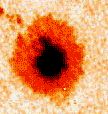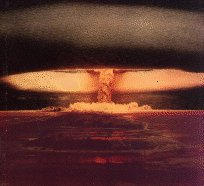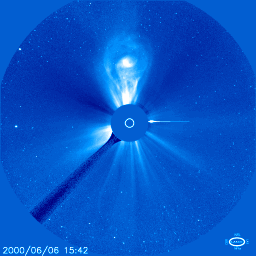|
0 members (),
388
guests, and
4
robots. |
|
Key:
Admin,
Global Mod,
Mod
|
|
|
|
Joined: Oct 2009
Posts: 14
Junior Member
|
OP

Junior Member
Joined: Oct 2009
Posts: 14 |
The big problems of nuclear fusion research are:
Nobody has seen a stable nuclear fusion reactor, we do not know what a stable nuclear reactor looks alike; we even have not a concept about stable nuclear fusion reactors.
At present time, the sun is the only place can we find a stable nuclear fusion reactor.
In fact, sunspots are one kind of standard stable nuclear fusion reactors.
Then, how can we know that sunspots are stable nuclear fusion reactors?
Every sunspot has a magnetic field. The magnetic field of a circular sunspot is similar to the magnetic field at the end of a long solenoid.
Some astronomers such as Hale and Cowling want to use circular electric currents to simulate the magnetic fields of the sunspots.
The circular electric currents are very large (1,000,000,000,000 Amperes for middle size circular sunspots), if we use a long solenoid to simulate the magnetic field of a circular sunspot.
In nuclear fusion experiments such as Z-pinch experiments, hollow cylindrical plasmas (a long solenoid) with large circular electric currents will pinch and form high temperature high density hollow cylindrical plasmas, and nuclear fusion reactions will happen in these plasmas.
So, strong stable magnetic fields of the sunspots just mean that there are stable nuclear fusion reactions in the sunspots.
But there is a problem, who produce the large circular electric currents of the long solenoids of the sunspots?
Astronomers think that sunspots are magnetic flux tubes, because nobody knows how to produce these large circular electric currents of long solenoids.
In high temperature plasmas, large circular electric currents just mean that large number of electrons, protons and ions move circularly in different direction or in same direction with different speed.
According to Newton’s three laws of motion (notice: Do not use Euler equation and Navier-Stokes equation of fluid mechanics), we need a centripetal force to drive the electrons, protons and ions move circularly.
But there are problems:
There are different kinds of centripetal forces, so what kind of the centripetal force drives these electrons, protons and ions of plasmas move circularly? Can this centripetal force describe all the plasmas motions of the sunspots (include Evershed flow)? Who produce this centripetal force?
|
|
|
|
|
Joined: Oct 2009
Posts: 14
Junior Member
|
OP

Junior Member
Joined: Oct 2009
Posts: 14 |
We cannot get an answer just by studying sunspots, we must study other phenomena.
Sunspots must be similar to atomic bombs, hydrogen bombs and hurricanes, if sunspots are stable nuclear fusion reactors, why? Because all of them release huge amount of heats continuously or in pulse manner, they are heats phenomena.
Then, what are similarity and differences among atomic bombs, hydrogen bombs, hurricanes and sunspots?
(1) Eyes
The umbrae of the sunspots are just the eyes of the sunspots, like the eyes of hurricanes.
(2) Eyewalls and magnetic fields
The magnetic fields of circular sunspots can be simulated by long solenoids with large circular electric currents. These long solenoids are just eyewalls of the sunspots, like eyewalls of the hurricanes. There are heavy rains in the eyewalls of the hurricanes; but there are large circular electric currents and nuclear fusion reactions in the eyewalls of the sunspots.
(3) Evershed flow
Atomic bombs, hydrogen bombs, hurricanes and sunspots all have Evershed kind of outflows. But velocity of the Evershed flow of the sunspot is very large (1-9km/s).
(4) Low temperature
The temperatures of the sunspots and some mushroom clouds of hydrogen bombs are lower than that of their surrounding atmosphere.
(5) Latitude distribution and periodical cycles.
Hurricanes are similar to sunspots in latitude distribution and periodical variations of numbers.
(6) Energy
Atomic bombs, hydrogen bombs, hurricanes and sunspots all are heat phenomena.
Conclusion:
Some astronomers such as John Herschel and Hale think that sunspots are cyclone vortices of the sun.
In fact, sunspots are just hurricanes of the sun, and these hurricanes have large circular electric currents and nuclear fusion reactions in their eyewalls.
So sunspots are one kind of standard stable nuclear fusion reactors.
The complex structures and motions of atomic bombs, hydrogen bombs, hurricanes and sunspots are caused by heats, so heats can produce some kinds of forces directly (Notice: Do not use Euler equation and Navier-Stokes equation of fluid mechanics). Certainly, electromagnetic forces play a role in eyewalls of the sunspots.
|
|
|
|
|
Joined: Oct 2009
Posts: 14
Junior Member
|
OP

Junior Member
Joined: Oct 2009
Posts: 14 |
How can we describe sunspots mathematically?
Astronomers think that the sun can maintain stable nuclear fusion reactions in its inner core just by a centripetal force (gravity).
Fusion scientists think that they can achieve stable nuclear fusion reactions just by electromagnetic forces.
Sunspots are simple phenomena, if we know that heats can produce forces directly.
In fact, sunspots kind stable nuclear fusion reactors are governed by a centripetal force and electromagnetic forces.
|
|
|
|
|
Joined: Jul 2008
Posts: 498
Superstar
|

Superstar
Joined: Jul 2008
Posts: 498 |
In fact, sunspots are one kind of standard stable nuclear fusion reactors...
The common understanding is, temperature of sunspots is too low to mainstain thermonuclear fusion. In fact, this fusion is active only at the relativelly small zone at the center of Sun, from which most of solar neutrinos is generated. IMO sunspots are kind of bubbles in solar plasma, which are raising to the surface, like bubbles are raising to the surface of fluid - so they can exist only limited amount of time, before they burst or dissolve.
|
|
|
|
|
Joined: Oct 2009
Posts: 14
Junior Member
|
OP

Junior Member
Joined: Oct 2009
Posts: 14 |
In fact, sunspots are one kind of standard stable nuclear fusion reactors...
The common understanding is, temperature of sunspots is too low to mainstain thermonuclear fusion. In fact, this fusion is active only at the relativelly small zone at the center of Sun, from which most of solar neutrinos is generated. IMO sunspots are kind of bubbles in solar plasma, which are raising to the surface, like bubbles are raising to the surface of fluid - so they can exist only limited amount of time, before they burst or dissolve. Some mushroom clouds of hydrogen bombs are black too, that is, their temperatures are lower than that of their surrounding atmosphere. The temperatures of umbrae of the sunspots are approximate 4,500k, but the temperatures of plasmas in eyewalls of sunspots are certainly above ten million Kelvin. At present, astronomers think that sunspots are magnetic flux tubes, sunspots cannot be some kind of bubbles, because bubbles cannot produce magnetic fields of sunspots.
|
|
|
|
|
Joined: Jul 2008
Posts: 498
Superstar
|

Superstar
Joined: Jul 2008
Posts: 498 |
Some mushroom clouds of hydrogen bombs are black too.. In nuclear bomb the thermonuclear fusion occurs during few milliseconds after explosion only - all the rest are just a thermal effects. I can be proven easily by measurements of neutron flux. In fact, whole thermonuclear reaction is finished at the moment, when flash of explosion dims temporarily.  sunspots cannot be some kind of bubbles, because bubbles cannot produce magnetic fields of sunspots. Bubbles in plasma, i.e. charged gas can. Of course, bubble model is quite simplified - but it can explain, what how sunspot can appear and disappear at surface of Sun in natural way. spot  
|
|
|
|
|
Joined: Oct 2009
Posts: 14
Junior Member
|
OP

Junior Member
Joined: Oct 2009
Posts: 14 |
Some mushroom clouds of hydrogen bombs are black too.. In nuclear bomb the thermonuclear fusion occurs during few milliseconds after explosion only - all the rest are just a thermal effects. I can be proven easily by measurements of neutron flux. In fact, whole thermonuclear reaction is finished at the moment, when flash of explosion dims temporarily.  sunspots cannot be some kind of bubbles, because bubbles cannot produce magnetic fields of sunspots. Bubbles in plasma, i.e. charged gas can. Of course, bubble model is quite simplified - but it can explain, what how sunspot can appear and disappear at surface of Sun in natural way. spot   “Some mushroom clouds of hydrogen bombs are black,” I just want to say that mushroom clouds of hydrogen bombs can have low temperature areas and high temperature areas at same time, so do sunspots. I still do not know how a bubble can produce the magnetic field of a sunspot. In solar physics, it is very difficult to explain the origin of the magnetic fields of sunspots.
|
|
|
|
|
Joined: Oct 2009
Posts: 14
Junior Member
|
OP

Junior Member
Joined: Oct 2009
Posts: 14 |
About thirty years ago I read somewhere that the fusion reaction going on in the sun is happening several quadrillion times more slowly than the reaction taking place in a hydrogen bomb. The reason put forth in the article I read was that the fusion reaction going on in the sun is with light hydrogen-not deuterium or tritium.
According to the article, in order to initiate a fusion reaction with light hydrogen, high heat and pressure are necessary-heat and pressure that's only possible at the center of large bodies of matter such as stars and planets. It's impossible to attain the necessary levels of heat and pressure to initiate a light hydrogen fusion reaction in the laboratory.
A light hydrogen fusiio reaction is not an explosion. It's a slow burn.
I don't have time now but I'll google around and see what I can find on this later. Pinch, pinch, pinch. In above posts, I have already pointed out that the eyewalls of sunspots have huge amounts of the circular electric currents (1,000,000,000,000 Amperes for middle size circular sunspots), so plasmas in eyewalls of sunspots are in pinch state, that is, in high temperature (above ten million Kelvin) high density state, so stable nuclear fusion reactions can happen in eyewalls of sunspots. Z-pinch fusion experiments are done almost every day; do you not believe these experiments? Astronomers think that the sun can maintain stable nuclear fusion reactions in its inner core just by a centripetal force (gravity), but sunspots kind stable nuclear fusion reactors are governed by a centripetal force and electromagnetic forces, their mechanisms are different.
|
|
|
|
|
Joined: Oct 2009
Posts: 14
Junior Member
|
OP

Junior Member
Joined: Oct 2009
Posts: 14 |
Hi,FatFreddy.
A hydrogen bomb has a spherical shock wave (explode), because its heats are released too fast.
A sunspot kind nuclear fusion reactor is very different from a hydrogen bomb.
Plasmas in eyewalls of sunspots are in pinch state, that is, in high temperature high density state, so stable nuclear fusion reactions can happen continuously at a certain rate in eyewalls of sunspots, so there are no spherical shock waves in sunspots.
|
|
|
|
|
Joined: Jul 2008
Posts: 498
Superstar
|

Superstar
Joined: Jul 2008
Posts: 498 |
Plasmas in eyewalls of sunspots are in pinch state Pinch configuration is different. Plasma in sunspots belongs into coldest places on the Sun, which refuses your theory effectively.
|
|
|
|
|
Joined: Oct 2009
Posts: 14
Junior Member
|
OP

Junior Member
Joined: Oct 2009
Posts: 14 |
Plasmas in eyewalls of sunspots are in pinch state Pinch configuration is different. Plasma in sunspots belongs into coldest places on the Sun, which refuses your theory effectively. In above posts, I have already pointed out that the eyewalls of sunspots have huge amounts of the circular electric currents (1,000,000,000,000 Amperes for middle size circular sunspots), so plasmas in eyewalls of sunspots will pinch and be in pinch state, that is, in high temperature (above ten million Kelvin) high density (high pressure) state, so stable nuclear fusion reactions can happen in eyewalls of sunspots. Reference: Liberman, M. A., De Groot, J. S., Toor, A. & Spielman, R. B. 1999 Physics of High-Density Z-Pinch Plasmas, Springer-Verlag New York, Inc., New York. Ribe, F. L. 1975 Fusion Reactor Systems, Rev. Mod. Phys. 47, 7-41. Ryutov, D. D., Derzon, M. S. & Matzen, M. K. 2000 The Physics of Fast Z Pinches, Rev. Mod. Phys. 72, 167-223. Sheffield, J. 1994 The Physics of Magnetic Fusion Reactors, Rev. Mod. Phys. 66, 1015-1103.
|
|
|
|
|
Joined: Jul 2008
Posts: 498
Superstar
|

Superstar
Joined: Jul 2008
Posts: 498 |
the eyewalls of sunspots have huge amounts of the circular electric currents (1,000,000,000,000 Amperes for middle size circular sunspots), so plasmas in eyewalls of sunspots will pinch and be in pinch state - The flux and circulation in pinch and sunspots are different
- The currents in sunspot are spread over area larger then our planet, whereas in pinch are concentrated into whisker
- The sunspots are coldest places on Sun
- No signs of gamma ray activity were observed in sunspots
|
|
|
|
|
Joined: Oct 2009
Posts: 14
Junior Member
|
OP

Junior Member
Joined: Oct 2009
Posts: 14 |
the eyewalls of sunspots have huge amounts of the circular electric currents (1,000,000,000,000 Amperes for middle size circular sunspots), so plasmas in eyewalls of sunspots will pinch and be in pinch state - The flux and circulation in pinch and sunspots are different
- The currents in sunspot are spread over area larger then our planet, whereas in pinch are concentrated into whisker
- The sunspots are coldest places on Sun
- No signs of gamma ray activity were observed in sunspots
Why do you think that sunspots are the coldest places on the sun? Sunspots are in active regions (AR) of the sun, the soft X-ray and X-ray photos reveal that almost all high temperature (above one million Kelvin) high energy phenomena of the sun are related to the sunspots; some CMEs and solar flares of the sun are caused by sunspots too. Do you not think that hollow cylindrical plasmas with large circular electric currents (1,000,000,000,000 Amperes for middle size circular sunspots) will pinch? Z-pinch fusion experiments are done almost every day; do you not believe these experiments? You think that sunspots are very large, but so do circular electric currents (1,000,000,000,000 Amperes for middle size circular sunspots).
|
|
|
|
|
Joined: Oct 2009
Posts: 14
Junior Member
|
OP

Junior Member
Joined: Oct 2009
Posts: 14 |
the eyewalls of sunspots have huge amounts of the circular electric currents (1,000,000,000,000 Amperes for middle size circular sunspots), so plasmas in eyewalls of sunspots will pinch and be in pinch state - The flux and circulation in pinch and sunspots are different
- The currents in sunspot are spread over area larger then our planet, whereas in pinch are concentrated into whisker
- The sunspots are coldest places on Sun
- No signs of gamma ray activity were observed in sunspots
The temperatures of umbrae of the sunspots are approximate 4,500k; they are almost 1,000k lower than that of their surrounding atmosphere. Some mushroom clouds of hydrogen bombs are black too, that is, their temperatures are lower than that of their surrounding atmosphere.  The lower temperature of sunspots and hydrogen bombs is a simple phenomenon of gas dynamics. The lower temperature phenomenon of sunspots is a proof, which can prove that sunspots are stable nuclear fusion reactors. But you use this proof to reject that sunspots are stable nuclear fusion reactors. I have a question: how do you explain why temperatures of umbrae of the sunspots are lower than that of their surrounding atmosphere?
|
|
|
|
|
Joined: Oct 2009
Posts: 14
Junior Member
|
OP

Junior Member
Joined: Oct 2009
Posts: 14 |
Vortex models and sunspots
Vortex models of sunspots are very important in history of sunspots. In fact, the stable nuclear fusion reactor model of the sunspot is a vortex model too, this model go a step forward from old vortex models of sunspots, because Hale's vortex of sunspots will evolve into stable nuclear fusion reactors.
Hale, who discovered that every sunspot has strong magnetic fields, thought that the sunspots are vortices of the sun; these vortices drive the electrons move in circular orbits and produce the magnetic fields of the sunspots.
In above posts, I have already pointed out that sunspots are stable nuclear fusion reactors, if we use circular electric currents to simulate the magnetic fields of the sunspots.
|
|
|
|
|
Joined: Oct 2009
Posts: 14
Junior Member
|
OP

Junior Member
Joined: Oct 2009
Posts: 14 |
Newton, Euler equation and Navier-Stokes equation of fluid mechanics (1)
Newton said in preface of his Principia that rational mechanics will be the science of motions resulting from any forces whatsoever, and of the forces required to produce any motions, accurately proposed and demonstrated. He said that for all the difficulty of philosophy seems to consist in this--from the phenomena of motions to investigate the forces of the nature, and then from these forces to demonstrate the other phenomena; and to this end the general propositions in the first and second book are directed. In the third book we give an example of this in the explication of the system of the world; for by the propositions mathematically demonstrated in the former books, we in the third derive from celestial phenomena the forces of gravity with which bodies tend to the sun and several planets. Then from these forces, by other propositions which are also mathematical, we deduce the motions of the planets, the comets, the moon, and the sea. I wish we could derive the rest of the phenomena of nature by the same kind of reasoning from mechanical principles.
Newton said that for all the difficulty of philosophy seems to consist in this--from the phenomena of motions to investigate the forces of the nature, and then from these forces to demonstrate the other phenomena. In fact, Newton’s main idea, or his principle of philosophy consists in this--from the phenomena of motions to investigate the forces of the nature, and then from these forces to demonstrate the other phenomena. Newton needs mathematical tools, when he investigates forces from the phenomena of motions and deduces other phenomena from these forces; so Newton writes book Ⅰand book Ⅱ; these two books are just mathematical tools. Book Ⅲ demonstrates Newton’s main idea or principle of philosophy--from the phenomena of motions to investigate the forces of the nature, and then from these forces to demonstrate the other phenomena; Newton derives gravity from celestial phenomena of the solar system, and then deduces other phenomena of the solar system by the gravity. Certainly Newton thinks that he can solve other natural phenomena by his main idea or principle of philosophy.
In fluid mechanics, we use Euler equation and Navier-Stokes equation to describe the phenomena of the fluid motions; Euler equation and Navier-Stokes equation use pressure forces, friction forces, buoyant forces, and coriolis forces etc.
It is obvious that Euler, Navier and Stokes did not fully understand Newton’s Principia, and did not follow Newton’s main idea or the mechanical principle.
Newton wants to derive forces from phenomena of motions, but Euler, Navier and Stokes do not; Newton wants to deduce other phenomena by the forces, which are derived from the phenomena of motions, but Euler, Navier and Stokes deduce the phenomena of fluid motions by pressure forces, friction forces, coriolis forces, and buoyant forces etc. and none of these forces is derived from phenomena of fluid motions.
Euler, Navier and Stokes omit the first process of Newton’s main idea or the mechanical principle: from the phenomena of motions to investigate the forces of the nature.
Why does Newton emphasis that a force must be derived from the phenomena of motions?
|
|
|
|
|
Joined: Oct 2009
Posts: 14
Junior Member
|
OP

Junior Member
Joined: Oct 2009
Posts: 14 |
Newton, Euler equation and Navier-Stokes equation of fluid mechanics (2)
Why does Newton emphasis that a force must be derived from the phenomena of motions?
Because this is the best and the most accurate method, with which we can directly find the true causes and reasons (in Newton’s word, causes and reasons are just forces) of the motions.
Euler, Navier and Stokes do not follow Newton’s rule, and want to use pressure forces to describe all kinds of phenomena of fluid motions, this is a big mistake, nobody can guaranty that pressure forces are true causes and reasons of all kinds of fluid motions, because pressure forces are not derived from phenomena of fluid motions.
According to Newton’s rule, the forces, which will be used to describe all kinds of fluid motions, must be derived from the phenomena of fluid motions.
So Euler equation and Navier-Stokes equation are useless.
Newton is a Giant, so we must strictly follow him.
In mechanics, we just care about forces and motions, motions and forces, different kinds of forces produce different kinds of motions and different kinds of motions need different kinds of forces.
In mechanics, we just care forces, we do not need differential equations; we just see a gravity force when we see the solar system, we just see a centripetal force when we see hurricanes, and we just see a centripetal force and electromagnetic forces when we see sunspots, or in Newton’s word, we can derive a centripetal force from the phenomena of the fluid motions of hurricanes, and then we can use this centripetal force, and magnetic forces, to demonstrate the plasmas motions of the sunspots.
Batchelor, G. K. 1994 An Introduction to Fluid Dynamics, Cambridge University Press, Cambridge.
Newton, I. 1686 Principia, Daniel Adee, New York (republished in 1848).
|
|
|
|
|
Joined: Oct 2009
Posts: 14
Junior Member
|
OP

Junior Member
Joined: Oct 2009
Posts: 14 |
Pinch, solar flares and CMEs. In above posts, we know that the eyewalls of sunspots have huge amounts of the circular electric currents (1,000,000,000,000 Amperes for middle size circular sunspots), so plasmas in eyewalls of sunspots will pinch and will be in high temperature (above 10 million Kelvin) high density state, and stable nuclear fusion reactions can happen in eyewalls of sunspots. Eyewalls of sunspots will eject masses when plasmas in eyewalls of sunspots pinch. Some CMEs and solar flares of the sun are caused by these pinch processes in eyewalls of sunspots. http://en.wikipedia.org/wiki/Solar_flarehttp://en.wikipedia.org/wiki/Coronal_mass_ejections  
|
|
|
|
|








